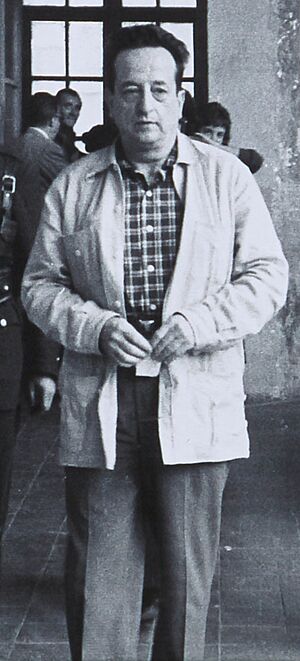Valentín Campa facts for kids
Valentín Campa Salazar (born February 14, 1904 – died November 25, 1999) was an important Mexican leader for railway workers. He also ran for president. Along with Demetrio Vallejo, he helped lead the big railway strikes in 1958. Campa also started the National Railroad Council and a secret newspaper called The Railwayman.
Contents
Early Life and Political Beliefs
Valentín Campa was born in Monterrey, Nuevo León. In 1927, when he was 23, he joined the Mexican Communist Party (Spanish: Partido Comunista Mexicano, PCM). He quickly became one of the youngest members of the party's main leadership group, the Central Committee.
Views on Important Issues
Campa had strong beliefs that sometimes caused disagreements within his party. For example, in 1940, he was removed from the PCM. This happened because he believed that harming political opponents would make them seem like heroes. He thought this would hurt the party's message.
Running for President
In 1976, Campa was chosen to be the presidential candidate for the PCM. Even though the party was not officially allowed to run candidates at the time, many people supported him. It's believed he received about one million votes, but these were never officially counted. This was because the main party, the PRI, had no official opponents.
Campa's campaign was called "The March for Democracy." His supporters used the slogan "Campa, Candidate of the Workers Struggle." During his three-month campaign, he held 97 meetings. He talked about important ideas like priests having political rights, freedom for students and teachers, and fairness within the Mexican army. Even without media coverage, over 100,000 people came to his meetings. More than 10,000 supporters attended his final event in Mexico City.
Working with Unions
From 1943 to 1947, Campa was a leader in the Union of Railroad Workers of the Mexican Republic (Spanish: Sindicato de Trabajadores Ferrocarrileros de la Republica Mexicana, STFRM). He worked to improve conditions for railway workers.
Forming New Groups
In 1947, Campa helped create a new group called the Special Confederation of Workers (Spanish: Confederacion Única de Trabajadores, CUT). This group broke away from a larger union called the Confederation of Mexican Workers (Spanish: Confederación de Trabajadores de México, CTM). The CUT included workers from telephone companies, railways, mines, and oil. Its main goal was to be a union movement that was truly independent and not controlled by the government.
Facing Challenges and Imprisonment
The next year, in 1948, the STFRM union faced internal problems. Some leaders accused Campa and another leader of misusing union money. The union's own committees were upset by these accusations, saying they brought the government into union matters. They believed these actions were meant to divide the union.
Despite this, the accusations led to a difficult time for Campa. He was wanted by the police. He tried to avoid arrest, arguing that he lived simply and could not have personally gained from the money. He said he only earned a small salary and owned no house or car. Campa was finally arrested in November 1949. He was held in Lecumberri Prison until 1952.
The Big Railway Strikes
In February 1959, the railway workers' contract was ending, and a new agreement was needed. On March 24, a major strike began. Workers from three big railway companies stopped working. Railway officials refused to accept the strike and told workers to return.
Government Reaction and Arrests
On March 26, the railway companies began firing workers. More than 13,000 people lost their jobs, and many were arrested. In protest, the STFRM union held a one-hour complete work stoppage. On March 27, the union leaders presented their demands directly to President Adolfo López Mateos. They asked for fair pay and an end to the harsh treatment. The president delayed, as over 100,000 people were on strike, causing huge financial losses.
On March 28, the government responded forcefully. Union leader Demetrio Vallejo and 28 others were taken by police and the army. The government sent in troops, fired another 9,000 workers, and arrested over 10,000 people. These arrests included not just railway workers but also teachers and activists.
Campa's Leadership in Hiding
Valentín Campa was also wanted by the authorities for his role in leading the strikes. He managed to stay hidden for a year, continuing to guide the railway strikes. While in hiding, Campa started the National Railroad Council in 1959. He also began publishing his secret newspaper, The Railwayman. Finally, in May 1960, Campa was arrested and sent to prison.
Release from Prison
Campa and Vallejo were sentenced to eleven years in prison. They were eventually released ten years later, in 1970. This happened because a growing student movement put pressure on the government to change unfair laws. On July 27, 1970, Valentín Campa and Demetrio Vallejo were set free.
See also
 In Spanish: Valentín Campa para niños
In Spanish: Valentín Campa para niños


